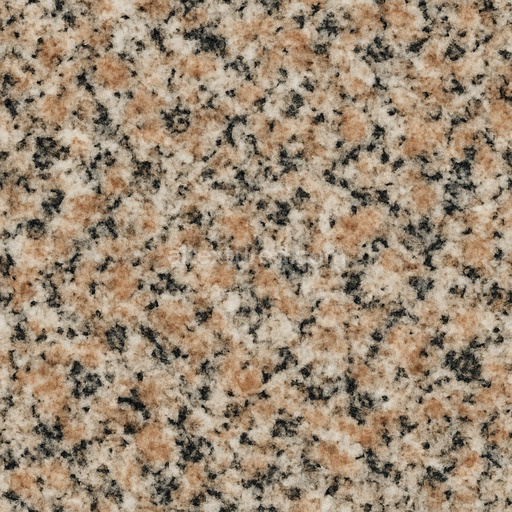This detailed granite texture seamless high resolution up to 8ktexture is an AI-generated stone surface meticulously designed to replicate the intricate natural composition of real granite. Granite, an igneous rock, primarily consists of interlocking mineral crystals such as quartz, feldspar, and mica, which combine to form a dense and durable substrate. This texture captures the precise granular structure, grain orientation, and subtle porosity that characterize authentic granite surfaces. The surface finish is represented as finely polished with nuanced variations in roughness, simulating the natural reflectivity and tactile quality of granite. Subtle color shifts and oxide layers are integrated to reflect the natural pigments and mineral inclusions, giving the stone its distinctive speckled appearance often seen in architectural and interior design applications.
From a materials and PBR workflow perspective, this seamless detailed granite texture seamless high resolution up to 8k excels in realism and versatility. The BaseColor (Albedo) channel presents the complex coloration and fine grain details inherent to granite, while the Normal map encodes delicate surface irregularities, enhancing depth perception without exaggerated displacement. The Roughness map balances glossy and matte areas to mimic the polished yet slightly uneven stone finish, and the Metallic channel remains minimal, consistent with granite’s non-metallic nature. Ambient Occlusion adds subtle shadowing that emphasizes grain boundaries and crevices, while the Height or Displacement map supports realistic parallax effects by accentuating larger surface undulations. This combination ensures a highly accurate 3D preview in rendering engines and game environments.
Optimized for seamless tiling and available in ultra-high resolution up to 8k, this tileable detailed granite texture seamless high resolution up to 8ktexture maintains exceptional clarity and detail, making it ideal for large-scale architectural visualization, product mockups, and immersive interior staging. It is fully compatible and ready for immediate use within Blender, Unreal Engine, and Unity, streamlining integration in diverse 3D workflows. For best results, it is recommended to carefully adjust the UV scale to match the specific scene context and fine-tune roughness values to preserve the natural elegance of polished granite surfaces without oversharpening the material details. This ensures a balanced, realistic appearance that enhances both static and real-time renders.
How to Use These Seamless PBR Textures in Blender
This guide shows how to connect a full PBR texture set to Principled BSDF in Blender (Cycles or Eevee). Works with any of our seamless textures free download, including PBR PNG materials for Blender / Unreal / Unity.
What’s inside the download
*_albedo.png — Base Color (sRGB)*_normal.png — Normal map (Non-Color)*_roughness.png — Roughness (Non-Color)*_metallic.png — Metallic (Non-Color)*_ao.png — Ambient Occlusion (Non-Color)*_height.png — Height / Displacement (Non-Color)*_ORM.png — Packed map (R=AO, G=Roughness, B=Metallic, Non-Color)

Quick start (Node Wrangler, 30 seconds)
- Enable the addon: Edit → Preferences → Add-ons → Node Wrangler.
- Create a material and select the Principled BSDF node.
- Press Ctrl + Shift + T and select the maps
albedo, normal, roughness, metallic (skip height and ORM for now) → Open.
The addon wires Base Color, Normal (with a Normal Map node), Roughness, and Metallic automatically.
- Add AO and Height using the “Manual wiring” steps below (5 and 6).
Manual wiring (full control)
- Create a material (Material Properties → New) and open the Shader Editor.
- Add an Image Texture node for each map. Set Color Space:
- Albedo → sRGB
- AO, Roughness, Metallic, Normal, Height, ORM → Non-Color
- Connect to Principled BSDF:
albedo → Base Colorroughness → Roughnessmetallic → Metallic (for wood this often stays near 0)normal → Normal Map node (Type: Tangent Space) → Normal of Principled.
If details look “inverted”, enable Invert Y on the Normal Map node.
- Ambient Occlusion (AO):
- Add a MixRGB (or Mix Color) node in mode Multiply.
- Input A =
albedo, Input B = ao, Factor = 1.0.
- Output of Mix → Base Color of Principled (replaces the direct albedo connection).
- Height / Displacement:
Cycles — true displacement
- Material Properties → Settings → Displacement: Displacement and Bump.
- Add a Displacement node: connect
height → Height, set Midlevel = 0.5, Scale = 0.02–0.08 (tune to taste).
- Output of Displacement → Material Output → Displacement.
- Add geometry density (e.g., Subdivision Surface) so displacement has polygons to work with.
Eevee (or lightweight Cycles) — bump only
- Add a Bump node:
height → Height.
- Set Strength = 0.2–0.5, Distance = 0.05–0.1, and connect Normal output to Principled’s Normal.
Using the packed ORM texture (optional)
Instead of separate AO/Roughness/Metallic maps you can use the single *_ORM.png:
- Add one Image Texture (Non-Color) → Separate RGB (or Separate Color).
- R (red) → AO (use it in the Multiply node with albedo as above).
- G (green) → Roughness of Principled.
- B (blue) → Metallic of Principled.
UVs & seamless tiling
- These textures are seamless. If your mesh has no UVs, go to UV Editing → Smart UV Project.
- For scale/repeat, add Texture Coordinate (UV) → Mapping and plug it into all texture nodes.
Increase Mapping → Scale (e.g., 2/2/2) to tile more densely.
Recommended starter values
- Normal Map Strength: 0.5–1.0
- Bump Strength: ~0.3
- Displacement Scale (Cycles): ~0.03
Common pitfalls
- Wrong Color Space (normals/roughness/etc. must be Non-Color).
- “Inverted” details → enable Invert Y on the Normal Map node.
- Over-strong relief → lower Displacement Scale or Bump Strength.
Example: Download Wood Textures and instantly apply parquet or rustic planks inside Blender for architectural visualization.
To add the downloaded texture, go to Add — Texture — Image Texture.

Add a node and click the Open button.

Select the required texture on your hard drive and connect Color to Base Color.


